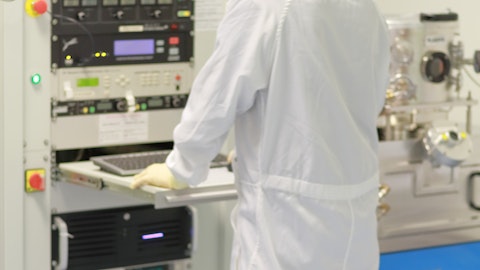Christopher Rolland: Yes. Understood. And then on the Signal Integrity side, that also sounds like it’s going to be down, but I was just wondering from a growth perspective, once this bounces back, are you most optimistic around kind of data center, 5G and PON? And then just two quick ones for Emeka. Book-to-bill, I’m going to assume less than one, but if you have any other thoughts there? And then the turns needed in your guidance that you usually give as well?
Mohan Maheswaran: So, Chris, let me just touch on the Signal Integrity product kind of momentum. Yes, it’s down in Q4, it was down in Q1. Obviously, we guided to that being down again significantly. I would say most of that is just inventory situation in China. We have a lot of good design win momentum in our Signal Integrity product group across all three of the major segments. So in hyperscale data center in North America, which is good. So it’s not China. In our base station business, again, we have momentum in China, but we also have momentum outside China, which is also good. And then in our PON business, similarly, I think we’re starting to see some growth outside China, although China is still a very large consumer of our PON products. So yes, I think Signal Integrity — my sense is Q1 is going to be near the bottom, and we’re going to be coming out of that quite quickly would be the comment I would make.
Emeka Chukwu: And Chris, on the bookings side. The book-to-bill was less than one. But on the positive side, the bookings were actually up for the legacy business was actually up about 10% during Q4. The bookings are still pretty much on the lower end of typical run rate, but it was very pleasing to see that it was up in Q4. And so far this quarter, it seems to be trending up sequentially as well. So those things are still pretty subdued, but at least it is encouraging to see that the bookings are beginning to show signs of life. And I think in Mohan’s prepared remarks, he talked about us needing about 16% TAM to achieve the midpoint of revenue guidance.
Christopher Rolland: Awesome. Thanks guys.
Operator: And we do have a follow-up question from Craig Ellis with B. Riley. Please proceed.
Craig Ellis: Yes, thanks for taking the follow-up. Emeka, I just wanted to go back to the gross margin point. I thought in your prepared remarks that you had said you had expected 150 to 180 basis points of gross margin through this year, so from 48.5% to 50-ish. But then I thought later, I heard you say 150 to 180 basis points per quarter, which the Semtech business really inflects off this very unnaturally low level would make sense. Can you just clarify if it’s the former or the latter? And then I’ll ask a follow-up.
Emeka Chukwu: So what I did say was 100 to 150 basis points for the rest of the year. I think maybe what was confusing was the person who asked the question before sort of framed as 100 to 150 per quarter. No, that’s not what I guided to. I guided to 100 to 150 basis points for the remainder of the year.
Craig Ellis: For the remainder of the year. Got it. And then that leads me to the follow-up question, which is if we’re going to exit somewhere around 49.5% to 50% gross margin this year. As we look at fiscal ’24, I know you’ve given us the three drivers to gross margin expansion towards the target model. But how would you expect fiscal ’24 margin acceleration to compare to what you’d expect this year — or excuse me, fiscal ’25 versus fiscal ’24? I think you know what I’m talking about.
Emeka Chukwu: I would expect to see continued gross margin expansion on an annual basis every year for the next several years. And I think for FY ’25, I wouldn’t be — I’m not guiding to it, but I would probably still expect to see something in the neighborhood of 150 to 200 basis points of gross margin expansion just because at that point, the expectation is that the environment has normalized and business is — a lot of the macro issues have gone out and the Semtech business, right, is rebounding to the levels that we expect. Also, at those levels, some of the material cost synergies that we’ve identified on the Sierra side, will probably be completely achievable. In addition, also hoping that I will start to see early signs that the acquisition that is cellular, the availability of cellular connectivity is leading to new use cases beginning to ramp.
We should also expect to see the growth in the annual recurring revenue for Sierra’s business. We have managed connectivity and a little bit of the LoRa Cloud. In addition to the fact that the LoRa IP, which we have not really talked about a lot, which is actually now beginning to do very well, probably averaging about $2 million a quarter, should continue to also increase. So there are definitely a lot of opportunity. There are a lot of things that would really lead to see some decent gross margin expansion on an annual business from now going forward.
Craig Ellis: That’s helpful color. Thank you, Emeka.
Operator: We have reached the end of our question-and-answer session. I would like to turn the conference back over to Mohan for closing comments.
Mohan Maheswaran: Thank you. In closing, while we face more macroeconomic challenges in Q1, we do believe we are near the bottom. Semtech is a very resilient company, and I’m confident that we will successfully manage through the headwinds we currently face and deliver profitable growth in the years ahead. With that, we appreciate your continued support of Semtech and look forward to updating you on next quarter. Thank you.
Operator: Thank you. This will conclude today’s conference. You may disconnect your lines at this time, and thank you for your participation.
Follow Semtech Corp (NASDAQ:SMTC)
Follow Semtech Corp (NASDAQ:SMTC)
Receive real-time insider trading and news alerts





